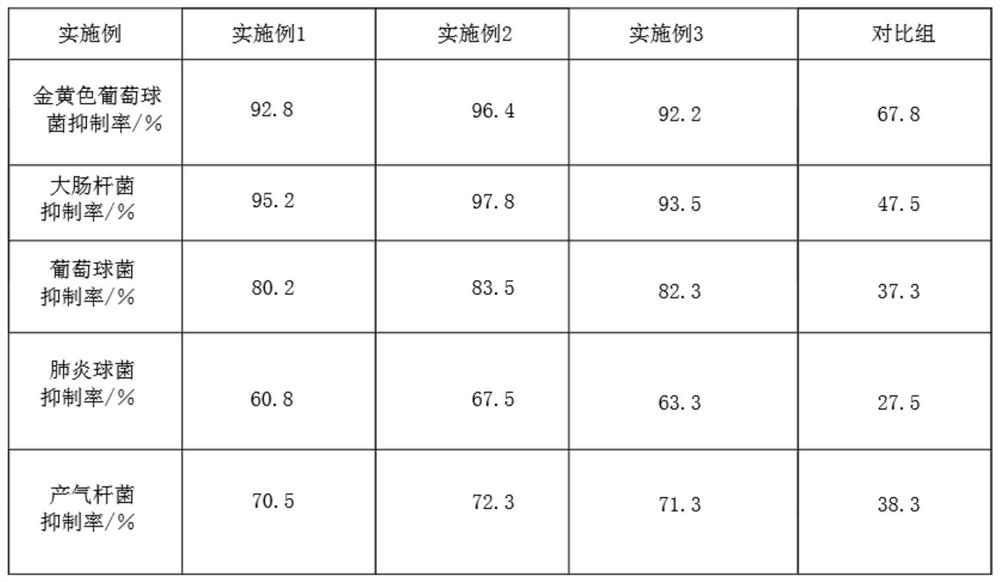Formula and preparation method of antiviral and antibacterial composite plant essential oil
A plant essential oil, antiviral technology, applied in the direction of antiviral agents, medical preparations with non-active ingredients, medical preparations containing active ingredients, etc. The effect of convenient and quick administration, improving human function and concise steps
- Summary
- Abstract
- Description
- Claims
- Application Information
AI Technical Summary
Problems solved by technology
Method used
Image
Examples
Embodiment 1
[0036] see figure 1 , a formula and preparation method of antiviral and antibacterial compound plant essential oil, comprising the following steps:
[0037] S1: Material selection, choose 3 parts of cinnamaldehyde, 3 parts of litsea cubeba oil, 3 parts of lauric monoglyceride, 6 parts of caprylic acid ester, 6 parts of pomegranate peel, 38 parts of silicon dioxide and glyceryl butyrate 8 parts are prepared, and 6 parts of pomegranate peel are washed and ground into powder;
[0038] S2: Preliminary mixing of materials, 3 parts of cinnamaldehyde obtained in S1 and 3 parts of litsea cubeba oil are placed in the liquid mixing tank for mixing, the mixing time is 2 minutes, and the mixing speed is 200r / min. After mixing, the pomegranate peel 6 parts obtained in S1 38 parts of lauric acid monoglyceride and 6 parts of caprylic acid caprate obtained in S1 were mixed for 2nd time in the liquid mixing tank. The mixing time was 4min and the mixing speed was 350r / min. Put 8 parts of glyc...
Embodiment 2
[0045] see figure 1 , a formula and preparation method of antiviral and antibacterial compound plant essential oil, comprising the following steps:
[0046] S1: Material selection, choose 2 parts of cinnamaldehyde, 2 parts of litsea cubeba oil, 3 parts of lauric monoglyceride, 5 parts of capric acid ester, 7 parts of pomegranate peel, 40 parts of silicon dioxide and glycerin butyrate as mentioned in the material. 10 parts of esters are prepared, and 7 parts of pomegranate peels are cleaned and ground into powder;
[0047] S2: Preliminary mixing of materials. Place 2 parts of cinnamaldehyde obtained in S1 and 2 parts of litsea cubeba oil in the liquid mixing tank for mixing. The mixing time is 1 minute and the mixing speed is 250 r / min. 2.5 parts of monoglyceride laurate and 5 parts of caprylic acid caprate obtained in S1 Put 10 parts of glyceryl butyrate in the liquid mixing tank for the third mixing, the mixing time is 8min, and the mixing speed is 550r / min, to obtain the m...
Embodiment 3
[0054] see figure 1 , a formula and preparation method of antiviral and antibacterial compound plant essential oil, comprising the following steps:
[0055] S1: Material selection, select materials 4 parts of cinnamaldehyde, 4 parts of litsea cubeba oil, 2 parts of lauric monoglyceride, 6 parts of caprylic acid ester, 5 parts of pomegranate peel, 36 parts of silicon dioxide and 10 parts of butyrin For preparation, 6 parts of pomegranate peels are cleaned and ground into powder;
[0056] S2: Preliminary mixing of materials, 4 parts of cinnamaldehyde obtained in S1 and 4 parts of litsea cubeba oil are placed in the liquid mixing tank for mixing, the mixing time is 1min, and the mixing speed is 300r / min. After the mixing is completed, 6 parts of pomegranate peel obtained in S1 2 parts and 36 parts of silicon dioxide are placed inside the liquid mixing tank for secondary mixing. The mixing time is 4 minutes and the mixing speed is 350 r / min. After mixing, 2 parts of lauric monogl...
PUM
 Login to View More
Login to View More Abstract
Description
Claims
Application Information
 Login to View More
Login to View More - R&D
- Intellectual Property
- Life Sciences
- Materials
- Tech Scout
- Unparalleled Data Quality
- Higher Quality Content
- 60% Fewer Hallucinations
Browse by: Latest US Patents, China's latest patents, Technical Efficacy Thesaurus, Application Domain, Technology Topic, Popular Technical Reports.
© 2025 PatSnap. All rights reserved.Legal|Privacy policy|Modern Slavery Act Transparency Statement|Sitemap|About US| Contact US: help@patsnap.com

